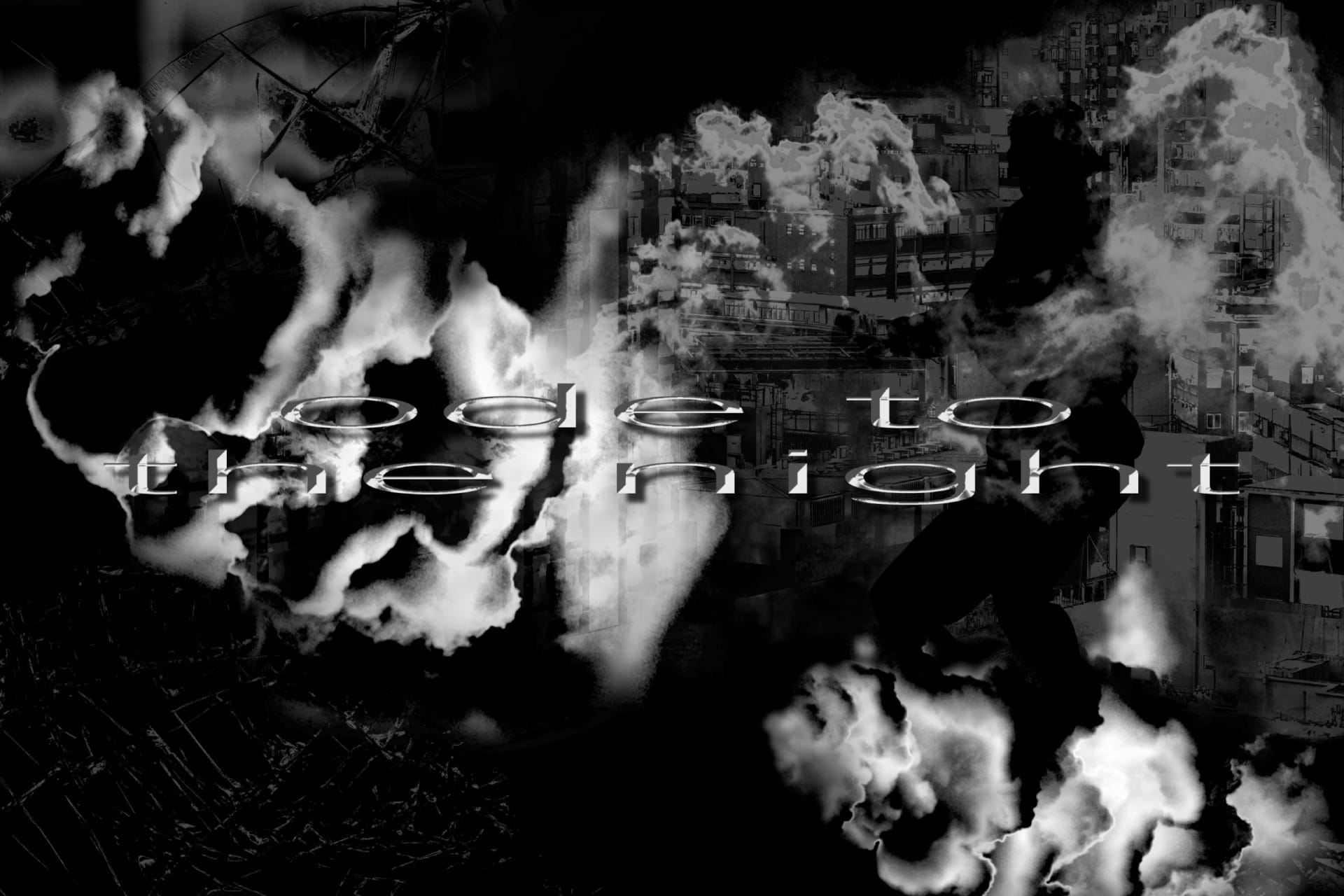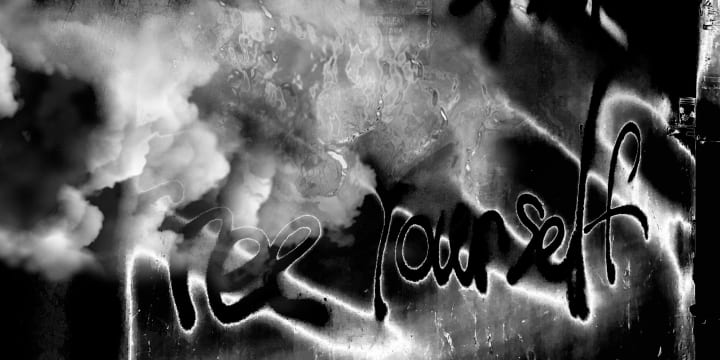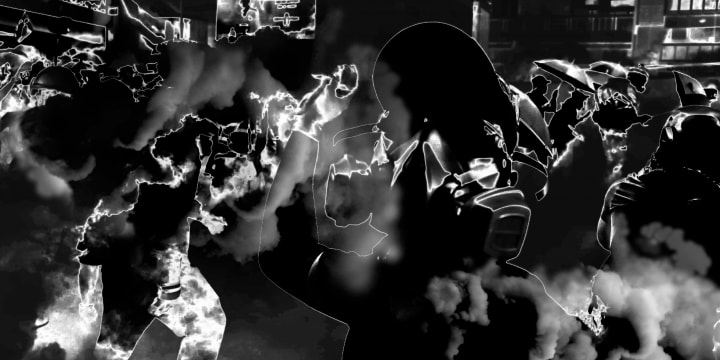
A Funeral Party for the First Neoliberal City
After COVID-restrictions loosen in Hong Kong, writer Jaime Chu discovers the ambiguous privileges of clubbing versus protesting.
-
A Funeral Party for the First Neoliberal City read by Whitney Wei

“If the police come, just cooperate and do whatever they tell you to do,” the door girl said as she stamped my wrist—a line I had never heard before at the club 宀 (pronounced “Mihn”).
It had been four months since I last went out because of the COVID-19 outbreak. Once I stepped inside, the room was thick with sweat and recognition. This was DJ Mr. Ho’s first time playing at Host’s monthly queer party at Mihn. The surprising Canto disco references (like a remix of the local short-lived ‘80s disco-pop duo Paradox) that he weaved into his funk-infused house set imbued the surreal privilege of being in the club again with even more unexpected joy. “NICE TO SEE YOU AGAIN,” we shouted into each another’s ears before retreating back to dance in our personally-allotted square-footage. It was as if no one had any time to waste—as if, even if we had fun now, we didn’t know the next time we’d all be on the dance floor again, singing along to an explosively frank rendition of The Human League’s “Don’t You Want Me.”
Despite the low infection rates in Hong Kong, the club was not the safest place to be in the middle of a pandemic. And despite the reopening of entertainment venues after an almost two-month-long shut-down, a ban on public gatherings of more than eight people was still in place (notwithstanding that the term “gathering” remains undefined in the legislation, and there is no guideline for the minimum distance allowed between people before they constitute a “gathering.”) However, there are only so many buts in a self-indulgent decision before it comes down to the risks we feel our guilt can take, even when the spectrum of moral responsibility might seem obvious.
The next day, as I got out of the subway station in Causeway Bay on the way to a restaurant, I saw a mass of people gathered in front of Sogo, the landmark department store at a busy intersection. I was half an hour late for brunch, but I suppose I arrived just in time for the day’s protest against a newly-announced draft of a National Security Law that would effectively put an end to Hong Kong’s autonomy from the Chinese Communist Party. I stopped in my tracks and texted my friend: Sorry does anybody want to come yell at the government instead?
Before the COVID-19 outbreak hit in late January, Hong Kong had been embroiled in a months-long civil movement that began as a protest against an anti-extradition bill and morphed into a fully-fledged resistance against the encroachment upon citizen rights by the Chinese Communist Party. As the unrest went on, the protests became increasingly illegal, and mass arrests threatened activists from turning out. The arrival of the pandemic had given the government another cover to ban public gatherings. In private, my friends and I held our breath for the first post-COVID demonstration, holding onto a bygone image and a naïve hope for the return of a 2-million-strong march like the one that had set everything into motion last June.
For almost half an hour, the crowd chanted as it drew more and more bystanders into its teeming mass. The riot police loomed. After three months of dormancy, people were simply elated for the right—or the possibility—to be angry as a vocal collective again. When the first dispersal warning flag went up, the group around me let out a whistle and cheered.
By the end of the day, at least 180 people would be arrested for illegal assembly and public misconduct.
The protests had come to define much of my social life in Hong Kong since June 2019. For the first few months, my personal and professional itinerary revolved around the calendar of protest actions. My meal times bent to the mercy of breaks during a march or late at night after a sit-in. I began to see more of some friends and less of others because of disruptions in public transport or concerns about safety in neighborhoods terrorized by police violence. For a while, there was an unspoken agreement about curfew, either self-imposed or de facto by the government.
During those weeks, I was grateful that, despite the political turmoil, a slim picking of clubs stayed open—that there was still a place to move towards in the dark, seemingly oblivious to state policing. The more our movements on the streets became regulated and monitored, the greedier I was for any chance to have the streets to myself. I would walk from the bars in Lan Kwai Fong to Mihn, making detours to pass by old spots for nostalgia’s sake, crossing the road to contemplate buying a snack I didn’t need at 7/11 and then crossing back—anything to stretch the night as far as I could.
Once inside the club, over a regulatory but democratic 4-4 beat, I relished the bodies that came together again for something outside of ourselves. Unlike the marches and chants during the day, this time, it was for pleasure. Disassociating, once a mechanism for self-preservation, became sublime.

The heyday of dance culture in Hong Kong coincided with the economic boom in the late ‘70s and early ‘80s, a period of neoliberal optimism some would memorialize as Hong Kong’s “Golden Age.” At its peak, there were over 50 dance halls, both “club-style” and more casual discotheques, spread across both sides of Victoria Harbor. Most of the glamor centered in a 10-minute radius on Canton Road in Tsim Sha Tsui—home to Hong Kong’s ocean liner terminal and bustling shopping hub. But nightlife in Hong Kong really owed its beginning to the gay community. When homosexuality was still criminalized in the colony under British law in the 1970s, Gordon Huthart, the gay son of a Lane Crawford director, and DJ Andrew Bull conceived of an alternative space outside of the hotel bar scene, which was the common entertainment venue at the time. Just before Christmas in 1978, their brainchild Disco Disco opened next to a dumpster station in the then-destitute district of Lan Kwai Fong. The modernist flyer, featuring a photo by celebrity photographer and designer Idris Mootee, advertised “Get away from the beast in your life / come to Disco Disco!” and a HKD$40 (about 4.55 EUR) cover that included two drinks. (At the time, the average daily wage of an industrial worker was HKD$33 or 3.76 EUR.)
Disco Disco was eclectic but high-profile. It quickly established itself as the hot spot for gay parties (alongside Sailor Bar at the Fairmont Hotel) and was frequented by queer Canto-pop icons such as Leslie Cheung, Danny Chan, and Roman Tam. “Gays swapped business cards with straights, Chinese smoked a Good Companion with expatriates … everyone was happy in the belief that Hong Kong had finally arrived,” journalist Liam Fitzpatrick described in his book about the early days of Lan Kwai Fong, Rats Liked It Well Enough: The 1997 Story.
Style was the equalizer, as curated by Disco Disco’s “New York-style”—that is to say, hauteur—door policy. This was how working-class club kids and underaged students came to share a dance floor with pop stars, radio hosts, and TV personalities. As anthropologist Sea-ling Cheng wrote in the essay “Consuming Places in Hong Kong: Experiencing Lan Kwai Fong,” “As a consumer space, Disco Disco was the cosmopolitan alternative to colonial exclusivity; as a sexualized space, Disco Disco was set up to challenge the heterosexual hegemony of the colony.”
If there was any anxiety about the impending end of colonial rule, it was subsumed by a collective hunger to absorb anything that was new and different. In the 2012 documentary Night of the Living Discoheads, former club kid and CD shop owner Martin recalled that the club’s music had a tendency to meld into itself amorphously, and the lighting was “nothing special,” but “you would’ve still been drawn to it like a moth to a flame, because there was nothing else like it elsewhere.”
The free-for-all rebellion at Disco Disco and multicultural decadence on the Canton Road disco strip would soon become counteracted by the founding of Lan Kwai Fong proper. The negotiations for the Sino-British Joint Declaration began in the fall of 1982. In 1983, four Austrians opened 1997 Café in the building opposite the back door of Disco Disco. According to Cheng, the European-style café was named after the year of the Handover (when Hong Kong would return under Chinese Communist Party rule) to “subvert the prevalent fear and uncertainty over Hong Kong’s future triggered by the Joint Declaration, and turned controversy into market appeal.” By 1985, expatriate bankers and lawyers had overtaken the L-shaped alley from the eclectic crowd at Disco Disco. Lan Kwai Fong prospered in spite of the de facto social exclusion of the local Chinese population.
Today, while top-40, table-service clubs dominate Lan Kwai Fong and mainstream nightlife, independent electronic music venues struggle against real estate prices, license difficulties, institutional resistance, a transient audience, and the survival demands in one of the most expensive cities to live in in the world. The names that used to pepper my younger going-out days (as a barely-legal magazine intern a decade ago) are now spoken of like dissipating smoke rings: Yumla, XXX, Bassment, and Golden Stupa. Even at a clueless age, I was first aware of a sense of precarity in something that was not supposed to flourish out of these places—something that became more clear to me as I grew into my early twenties at identity-forward, musically provocative, and anti-normative techno parties of late 2010s New York. I have come to realize the chase after the smoke is less about the fear of missing out than the fear of a ticking clock. Things can change at any moment, and you are lucky if they warn you beforehand. The generation that grew up around the time of the Handover understood this when they understood how certain historical forces lead to entropy. The generation that came after us—the most vigilant protesters on the streets—find meaning in the attempt. When a journalist friend once asked a 12-year-old student if the skirmishes with the riot police felt like a game sometimes, the student responded, “Yeah, it’s a game of life and death.”
As the new National Security Law came into effect on July 1st—the fear and anxiety of 1997 actualized—the city is once again becoming fractured between those who can leave and those who must stay. While the world has only grown more interconnected since the ’80s, the cosmopolitanism on the neoliberal dance floor never synthesized into the transnational future it once envisioned. Even as, concurrently, the global dance community reckons with the debt it owes to Black artists and heritage at the wake of the Black Lives Matter movement, the local, expat-led electronic music scene floundered in an almost ahistorical relationship to the rest of the world, not to mention its own community.

Among friends, we make fun of our own propensity of relating everything to the club, which, as the place where many of our early adult relationships formed, has come to structure our imagination of a public space. When we text, we end up riffing on the qualities of our ideal party. “No cover but $20 to leave” is my favorite hostage club concept. Clare’s ideal DJ is “good taste, punctual, not online.” But when we say we want “a club that is also a laundromat that is also a grocery store that is also a hot pot place,” we might actually be describing a commune. We might be a part of the generation that will never own a house, but we could aspire to realizing our ineffectual, utopian dreams of a world so otherwise rotten by insurmountable structural mistakes 12 hours or 12 months at a time. Even if the effort ultimately ends in ephemera, the politics of pleasure still make power visible in a way that should unsettle its seeming inevitability.
At the end of a Bookforum review of disco scholar Tim Lawrence’s Life and Death on the New York Dance Floor, 1980-1983 , Simon Reynolds asks, “how do you get the fascists to dance?” I thought of a clip from Berlin-based artist Isaac Chong Wei’s Rehearsal of the Futures: Police Training Exercises (2018). The video shows a choreograph of five riot police enacting combat moves in slow motion, so that the movements begin to take on the tenacity of a dance. Their limbs soften; their gaze becomes hollow. The slow fall looks tentative.
I am not sure if, at this point, state violence can be redeemed in any way. The human form it takes only reminds us that movement is a precarious right, before it becomes a privilege, and then an elusive freedom.
Jaime Chu is a writer and translator from Hong Kong.
Artworks by Sofia Apunnikova
Published July 06, 2020. Words by Jaime Chu.
